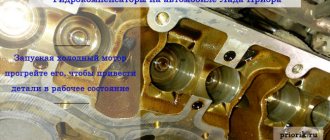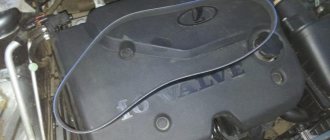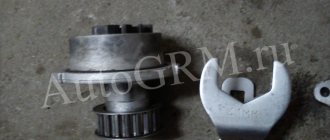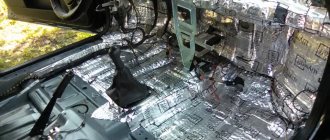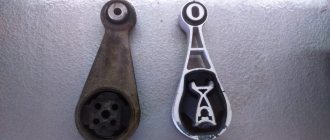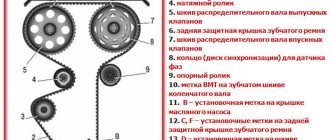Probably everyone who has encountered a 16-valve VAZ engine on a Priora knows about the problem of breakage. After which there will be expensive repairs - this is almost always the case, but there is a regulation according to which this unit must be changed after a certain mileage. The timing mechanism is a gas distribution mechanism responsible for operation by rotating the camshaft, intake and exhaust valves of the power unit.
In Priora cars with a VAZ 21126 engine (16 valves), there are 2 such shafts. The timing drive, together with the cooling system pump, is carried out by a toothed belt. The regulations for replacing the timing belt of a Priora car must be strictly observed. Unfortunately, 16 valves - of course, the dynamics of the Lada Priora car, but also the danger of a break. When a belt breaks, sad consequences arise (a bunch of bent valves, broken pistons, damage to the cylinder head). The technical regulations say about replacing the belt every 150,000 km. But experienced mechanics insist on replacing them every 50,000 - 60,000 km. due to non-compliance with the standard, with the actual service life and operating conditions. Replacing the timing belt of a Priora car can be done in a garage, with your own hands, although we must not forget about the marks on the pulleys. For one hundred, the price for replacing engine unit 126 (16 valves) is from 3,000 rubles. It is better to choose the gates brand for the timing belt itself - a set with 2 rollers is sold, its price starts from 5,000 rubles. There are cheap analogues for Priora, but you shouldn’t skimp! Read the article to the end and make sure that in a Priora car, it’s safer to do everything on time!
Timing belt on Priora 16 cl: its purpose
The timing drive part of the mechanism is made of high-quality materials. Provides synchronization of the operation of the intake and exhaust valves (16 pieces, two for intake and exhaust) with the engine operating strokes by transmitting the rotation of the crankshaft to the camshafts. At the same time, the belt drives the cooling system pump (pump). For improved adhesion to the surface of the pulleys, to avoid displacement along the camshaft marks on the inside, it has a toothed structure.
Standard belt - article number, price. Priora cars with engine 21126 are equipped at the factory with a LADA brand part, article No. 21126-1006040-00, 22mm wide. has 137 teeth, 22mm wide. Price is approximately from 1800 - 2200 rub.
Belt faults
Like any other car with a timing belt drive, the Priora belt may have the following malfunctions:
- cracking;
- delamination;
- deformation;
- break.
Cracking and delamination of the timing belt working surface is a consequence of:
- long-term operation;
- frequent temperature changes;
- contact with oil or coolant;
- malfunction of the water pump (pump);
- malfunction of the tension or support rollers.
These same factors, as well as improper tension adjustment, can cause belt deformation and breakage.
Replacing the timing belt: instructions
Let us note a slight difference in the procedure for replacing the belt on a Priora with and without air conditioning. You will need to first remove the belt and tensioner pulley of the generator (not to be confused with the timing tensioner) in order to dismantle the protective covers of the drive of the timing mechanism itself.
- Using a 15 mm socket, unscrew the tension roller of the generator, remove the belt itself (it is recommended to replace it together with the timing belt), access is open;
- Using a T-30 bit (asterisk), or a hexagon, unscrew 5 bolts of the upper cover (plastic casing) and 2 bolts of the lower timing drive cover;
- Disconnect the crankshaft sensor by disconnecting the corresponding chip located near the top cover;
- If it is necessary to replace the cooling system pump, you will have to lift the right drive wheel into the air with a jack. All this is needed to compare the marks of the camshaft pulleys with the marks on the block body;
- We rotate the raised wheel in 5th gear, or turn the crankshaft pulley with key number 17. Having matched the camshaft marks with the marks on the block body, it is necessary to turn on the neutral gear to avoid failure of the mark settings. Check the markings on the flywheel by removing the rubber plug at the top of the flywheel housing. Under the plug you can see part of the flywheel and the crown on it; align the flywheel mark with the triangular mark on the left side of the housing;
- If it is necessary to replace the pump, at this stage it is necessary to loosen the fastening of the 2 camshaft pulleys in order to avoid deformation of the valves when the gas distribution consumable is dismantled;
- To gain access to the crankshaft pulley, you need to turn the steering wheel as far as possible to the right or remove the wheel. You will need an assistant to remove the crankshaft pulley. Engage 5th gear, hold down the brake pedal, and use a 17mm key to unscrew the fastening bolt;
- ATTENTION! Left hand thread! Remove the pulley and thrust washer. Head 15mm;
- Unscrew the bolts securing the tension and thrust rollers, after dismantling which you can remove the timing belt. Install a new timing drive consumable. You need to apply tension by turning the tension roller with an offset center (the cutouts of the race and the tension roller bearing bushings must match). When reassembling, carefully monitor the marks on the camshaft pulleys and engine flywheel.
When replacing a part, the support and tension rollers are immediately changed - yes, the engine on the Priora is like that.
Lada Priora: timing belt, checking and tightening it
So, it has already been said above that if the timing belt breaks on a Priora, this leads to valve bending. It is quite obvious that it is better to check the condition of the belt often (every 40 thousand km). Let’s also add that if we consider when the timing belt is changed, this element, taking into account the features of its design and operation, should be replaced every 60 thousand km.
Experienced specialists even recommend checking the belt every 25 thousand km, and it is better to change belts every 50 thousand km. mileage or after 4 years of operation (whichever comes first). And this applies not only to Priora, but also to other cars with a timing belt drive.
Let's move on. You need to check the condition of the belt, as well as its tension, on a cold engine. Heating is allowed no higher than 35 degrees Celsius.
- If the car is equipped with air conditioning, then you need to remove the drive belt and tension roller;
- Then you should install the engine mount by slightly tightening the screws securing the mount itself. Next, use a wrench to unscrew the 5 screws securing the front upper timing cover.
- The cover can now be removed. To inspect the timing belt, the crankshaft should be turned clockwise. To do this, you need to engage 5th gear and push the car forward. You can also lift the car by hanging the front wheel and rotating it clockwise.
- The surface of the belt, especially its toothed part, should not be cracked, the teeth should be intact, without creases or other defects, the rubber should be solid, without delamination to the cord, etc. Also, the belt should not show signs of friction or overheating.
- The end parts should also be carefully inspected to ensure that delamination and damage are not allowed. Also, the belt should not diverge too much along the marks. If so, then the timing belt is too stretched.
- There should also be no traces of engine oil on the timing belt. Even if the belt is visually in good condition, it is important to understand that oil corrodes the rubber. For this reason, an oily belt should be replaced.
One way or another, detection of defects will require replacing the timing belt. Moreover, if you can see oil on the belt (you need to understand for sure that it is oil and not antifreeze), you first need to determine where it is coming from, eliminate the cause, and only then install a new timing belt.
It is also necessary to check the belt tension. To do this, you need to take into account that on a Priora car the timing marks are applied to the camshaft pulleys. To check, rotate the crankshaft clockwise until the marks on the camshaft pulleys align with the cutouts on the rear timing cover. If the pulleys were accidentally turned further than necessary, you will need to turn the crankshaft 2 turns.
If the timing belt is normally tensioned, the rectangular protrusion of the inner bushing of the tension roller coincides with the cutout of its outer race. If the belt itself is in order, and the indicated marks do not coincide slightly (more than ½ of the total width of the protrusion), then you need to adjust the timing belt tension. To solve this problem, it is necessary to locate the Priora timing tension pulley.
First, use a 15mm wrench to loosen the bolt securing the tension roller. In the case when the belt is loose, it is necessary to ensure precise alignment of the cutout of the outer race of the roller with the rectangular protrusion of the inner sleeve of the roller. Then use a 15mm wrench to tighten the tension roller bolt. The tightening torque is from 20 to 25 Newtons.
In fact, to tighten the belt, the tension pulley must be turned counterclockwise. If the belt needs to be loosened, then the roller is turned clockwise.
To do this, a special key is inserted into the grooves of the outer race of the roller (resembles two rods attached to the base). Next, the belt can be tensioned until the cutout of the outer race coincides with the rectangular protrusion of the inner sleeve. The end will be tightening the roller mounting bolt (tightening torque 34–41 Nm.).
Please note that if the timing belt is overtightened, this will shorten its service life, as well as the life of the pump, tension roller and guide roller. If the timing belt is not tensioned sufficiently, this also reduces its service life and can also cause a shift in valve timing.
At a minimum, the engine will run unstably, and if the timing belt jumps, it will bend the valves. If, after adjusting the tension, the marks do not match, the procedure must be repeated. If the tension cannot be adjusted, the timing belt should be replaced.
Weak link: pump, roller, belt
The reasons for repairing the timing unit are most often broken bearings of the tensioner roller and pump, as well as the timing belt. The pump also has to be changed if the seal of the structure is lost, causing loss of coolant. To replace it, you will have to remove the camshaft pulleys and the rear protective cover of the casing. Remove the generator roller tensioner fasteners (3 bolts), unscrew the 6 bolts (10mm) securing the casing, two of which are located under the camshaft pulleys. After removing the casing, unscrew the 3 bolts securing the pump.
The marks on the pulleys must match
Gas distribution mechanism
Lada Priora boasts a 16-valve engine producing 106 hp. With. and a working volume of 1.6 liters (there is also an 8-valve one, but it is not popular). The timing belt drive is the weak point of the timing belt. If it breaks, the pistons will inevitably bend the valves, and this will lead to large expenses for repairs.
Unlike the power unit with 8 valves, the Priora engine with 16 valves is equipped with two camshafts, each of which has its own gear. The mechanism is designed to remove exhaust gases and timely supply the fuel-air mixture to the combustion chambers due to the synchronous raising and lowering of the pistons (opening/closing of valves).
Due to the design features of the 16-valve engine, the timing belt of the Lada Priora is longer. In addition to the tensioner roller, the drive has an additional support roller.
When is it necessary to replace the timing belt on a Priora according to the regulations?
The mechanism requires constant attention to itself. The regulations for checking and replacing the timing belt of a Priora car with engine 21126 (16 valves) indicate regular condition checks every 10 - 15 thousand km. If you find any defects or damage to the structural integrity of the rubber part, replace it immediately.
Every 50 - 60 thousand mileage, it is necessary to change the spare part, regardless of its condition. Compliance with the regulations will help to avoid a number of extremely negative consequences that, in the most terrible scenarios, lead to almost a major overhaul of the car’s piston engine.
Why change the belt?
If you do not notice the problem in time and do not replace the belt with rollers, a break will not take long to occur. If this happens, only a major overhaul will help save the engine. In 90% of cases where the timing belt breaks on a 16-valve Priora engine, the valves fail (bend), as a result of which the cylinder head with the entire valve mechanism is damaged. In addition, the pump may also suffer.
If you notice the slightest damage to the belt, it needs to be changed urgently.
From the factory, 16-valve Prioras come with reinforced timing belts, which guarantee 100 thousand km of safe mileage. However, taking into account our operating conditions, especially in cold regions, as well as possible malfunctions in the operation of the water pump and rollers, it is recommended to replace it at least after 50 thousand kilometers.
It is necessary to change the timing belt on 16-valve Lada Priora engines complete with a tension and support roller.
Checking the condition of the belt
The inspection regulations for this unit require an inspection in a cold engine state. Remove the outer protective casing to allow visual contact with the surface of the gas distribution unit parts. Having gained access directly to the timing belt, rotating its drive, inspect both sides of the consumable in detail for the presence of any kind of defects (wear, broken teeth, protruding cord, rubber delamination, etc.). Tensioner rollers are subject to careful inspection; in the presence of mechanical damage and large play, they contribute to increased wear of the consumables. The presence of oil stains on the surface of a rubber technical part, which contribute to the destruction of its structure, is not allowed. If found, immediately remove from surface.
Necessary tools for replacement
Having decided that you need to replace the timing belt on a Priora, you should prepare the necessary material and tools. The materials will require a new timing belt. Moreover, you can buy both the original belt and analogues. The original belt product is also equipped with two rollers: a tensioner and a thrust roller. The cost of such a kit is about 5 thousand rubles.
Original kit for timing system on VAZ-2170
If necessary, you should purchase a new pump if the car’s mileage exceeds more than 100 thousand km and the product has never been changed. If you are replacing the pump, you will also need to replace the coolant.
This is interesting! Antifreeze needs to be replaced every 2 years, and antifreeze every 4-5 years.
Of the tools to replace the timing belt on a Lada Priora, 16 valves will be needed:
- Head at "17".
- Set of open-end wrenches.
- Screwdrivers.
- Hex key or T-30 sprocket, depending on the year of manufacture of the car.
- Special key for adjusting the roller. Comes with a set of belt and 2 rollers.
It is not necessary to install the Priora in the inspection hole, since most of the actions will be performed in the engine compartment. Once all the tools and materials are ready, you can start working.
What mileage should the car have to replace the belt?
Replacing the engine belt
It is necessary to change the belt, according to AvtoVAZ itself, when the Priora has a mileage of about 200,000 kilometers, however, it is believed that during short drives around the city this element wears out faster, therefore, according to surveys, some people change it already at 40,000 kilometers , others are only at 60 thousand kilometers. This part needs to be inspected every 50 thousand kilometers. The first signs that the timing belt needs to be replaced are the following:
- extraneous noise when the engine is running;
- difficulties when starting a Priora car;
- the engine has very strong vibration (to the point of trembling throughout the entire body);
- exhaust fumes are blacker than usual.
A low mileage of a car cannot always guarantee that a situation has not arisen where the belt needs to be changed. Very often, the belt drive wears out prematurely due to the fact that oil penetrates through the seals; cracks in the casing allow dirt to penetrate. These components quickly destroy the rubber of the belt, because it peels off from the cord, and dust mixed with oil gives a destructive abrasive effect. Here you need to eliminate the causes of oil leakage and visually inspect the part itself. It is believed that minor dirt can be removed with wiping paper or a rag (if there are no breaks), and it will still be a long time before it is really necessary to change the belt.
The belt must be replaced in a timely manner, without waiting for it to break, since the latter is very fraught in terms of engine repair costs (from 10-12 thousand rubles). This is due to the fact that the pistons in Priora engines do not have recesses for the valves, as was the case on the VAZ 2110, therefore, if the timing belt breaks, there is a high probability that the pistons will “meet” the valves, with the latter bending.
At high speeds, problems with the strength of the belt on the Priora can cause the pistons themselves to break and even bend the connecting rods. It would be good if there were no accidents.
Causes and consequences of a break in the timing mechanism drive
The reasons may lie in the following:
- Untimely replacement of a worn out drive.
- The belt tensioner or pulley is jammed.
- Natural “aging” of the belt material.
- Oil getting on the drive surface.
- Initial low drive quality.
- Defects in the form of cracks that appear during operation.
- Climatic conditions.
- Manufacturing defects.
Consequences of a break:
- Damage to valves.
- Failure of pistons and cylinder heads.
- Stopping the camshaft and crankshaft.
How to replace the Priora timing belt
So, having selected a suitable timing belt for the Priora (regardless of the manufacturer, it is important to select a 16-valve Priora timing belt), you can begin the replacement procedure. The width of the belt should be 22 mm, the number of teeth is 137
After removing the timing cover, you must first align the timing belt itself. To do this, the crankshaft and camshafts are placed at TDC on the compression stroke of the first cylinder.
To rotate the crankshaft, use a 17mm wrench to turn the bolt securing the auxiliary drive pulley clockwise until the marks on the camshaft toothed pulleys align with the marks on the rear drive cover.
Also, to check the position of the crankshaft, you need to remove the plug from the rubber (it is located on top of the clutch housing). The mark on the flywheel should be opposite the slot in the upper cover of the clutch housing.
Then you need to fix the crankshaft. To do this, when unscrewing the bolt securing the drive pulley of the mounted units, you should invite an assistant to engage 5th gear and press the brake.
Now the pulley can be removed, and the washer is removed in parallel. To make it easier to put everything back together, the camshaft pulleys can be fixed in relation to each other before removing the belt. Pre-prepared wooden pegs are suitable for this.
Wooden wedges can be lightly driven between the teeth of the pulleys. Then use a 15mm wrench to loosen the bolt securing the timing belt tension roller. The roller will turn, the belt tension will be small, which will allow it to be removed from the camshafts. The belt can now be removed from the pump and crankshaft pulleys.
It is important to ensure that after removing the belt, the crankshaft and camshafts no longer rotate, as the pistons and valves may accidentally collide!
As for replacing the timing belt, first change the tension roller, then the support roller. The rollers are removed along with the bolt and thrust washers. At the same time, you need to check the condition of the pump
It is important that there are no leaks of antifreeze, the pump shaft should rotate easily, there should be no backlash, etc. If the pump is not working, it also needs to be replaced
By the way, before installing new timing belt rollers on the Priora, the threads of the mounting bolts should be coated with a special fixing sealant. Also, the support roller mounting bolt can be immediately tightened (torque 34–41 Nm), while the tension roller mounting bolt should not be fully tightened at this stage.
Next, you can proceed to installing the timing belt.
Before installing it, it is important to check that the camshaft timing marks match the marks on the rear drive cover. If the accessory drive pulley is removed, in this case it is easy to determine the position of the crankshaft (the marks on the crankshaft toothed pulley must coincide with the mark on the oil pump cover)
Now all that remains is to put the timing belt on the crankshaft pulley. The main thing is to tension both parts of the belt, placing the front part behind the support roller. At the same time, the rear part is put on the pump pulley and pulled behind the tension roller. Then you can put the belt on the camshaft pulleys. If the pulleys were previously secured, all stoppers must be removed. You can then adjust the timing belt tension as described above.
The final stage is the installation of the drive pulley for the mounted units. After this, turn the crankshaft by the pulley mounting bolt 2 turns clockwise. Next, you should check that the marks on the crankshaft and camshafts match exactly, and that the belt itself is tensioned properly.
If deviations are noticeable, the entire adjustment and/or installation process should be repeated. If the marks coincide, you can completely tighten the tension roller bolt (torque from 34 to 41 Nm), as well as the attachment drive pulley bolt (bolt tightening torque 105 or 110 Nm).
